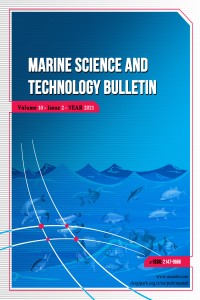A Binary Logistic Regression Model for Prediction of Feed Conversion Ratio of Clarias gariepinus From Feed Composition Data
Abstract
Keywords
Binary logistic regression Clarias gariepinus Feed conversion ratio Jaccard similarity score Numerical optimizer Proximate analysis
Supporting Institution
Ekiti State University
Project Number
-
Thanks
Dr. Familusi, E.B. IBM cognitive class team. Pilot Primary School, Mabudi, Langtang-South, Plateau State
References
- Aniebo, A. O., Erondu, E. S. & Owen, O. J. (2009). Replacement of fish meal with maggot meal in African catfish (Clarias gariepinus) diets. Revista Cientifica UDO Agricola, 9(3): 666–671.
- AOAC. (1990). Official Methods of Analysis, 13th edition. Association of Official Analytical Chemists.
- Chor, W. -K., Lim, L. –S. & Shapawi, R. (2013). Evaluation of feather meal as a dietary protein source for African catfish fry, Clarias gariepinus. Journal of Fisheries and Aquatic Science, 8(6): 697–705. https://doi.org/10.3923/jfas.2013.697.705
- Degani, G., Ben-Zvi, Y. & Levanon, D. (1989). The effect of different protein levels and temperatures on feed utilization, growth and body composition of Clarias gariepinus (Burchell 1822). Aquaculture, 76(3-4): 293-301. https://doi.org/10.1016/0044-8486(89)90082-3
- Dudusola, A. & Akinlade, S. T. (2014). The use of maggot meal in African cat fish feeding. Advances in Aquaculture and Fisheries Management, 1(5): 49–51. https://doi.org/10.46882/AAFM/1008
- Falaye, A. E., Omoike, A. & Adesina, S. B. (2015). Growth performance and nutrient utilization of catfish Clarias gariepinus fed varying inclusion level of fermented unsieved yellow maize. Continental Journal of Biological Sciences, 8(1): 14–23. https://doi.org/10.5707/cjbiolsci.2015.8.1.14.23
- FAO. (2016). The State of World Fisheries and Aquaculture 2016. Contributing to Food Security and Nutrition for All.
- Farahiyah, I. J., Zainal, A. A. R., Ahmad, A., Mardhati, M., Thayalini, K. & Yong, S. T. (2016). Evaluation of local feed ingredients based diets on growth performance of African catfish, Clarias gariepinus. Malaysian Journal of Animal Science, 19(2): 39–46.
- Li, M. H., Robinson, E. H., Bosworth B. G. & Torrans, E. L. (2014) Growth and feed conversion ratio of pond-raised hybrid catfish harvested at different sizes, North American Journal of Aquaculture, 76(3): 261-264. https://doi.org/10.1080/15222055.2014.911225
- NCSS. (2020). NCSS Statistical Software, Logistic Regression. NCSS, LLC. Kaysville, Utah, USA, https://ncss.com/software/ncss
- Ng, W. –K., Teh, S. -W, Chowdhury, K. M. A. & Bureau, D. P. (2013). On-farm feeding and feed management in tilapia aquaculture in Malaysia. In M. R. Hasan & M. B. New, (Eds.), On-farm feeding and feed management in aquaculture. FAO Fisheries and Aquaculture Technical Paper No. 583. Rome, FAO. pp. 407–431
- Oyekanmi, F., Omoniyi, I. & Akegbejo, S. (2013). Whole rocky fresh water prawns, Caridina africana as replacement for fish-meal in diets for African catfish (Clarias gariepinus). Proceedings of 28th Fisheries Society of Nigeria Annual Conference. pp. 366-370.
- USAID-HARVEST. (2011). Feed Conversion Ratio [Technical Bulletin]. www.CambodiaHARVEST.org
Abstract
Project Number
-
References
- Aniebo, A. O., Erondu, E. S. & Owen, O. J. (2009). Replacement of fish meal with maggot meal in African catfish (Clarias gariepinus) diets. Revista Cientifica UDO Agricola, 9(3): 666–671.
- AOAC. (1990). Official Methods of Analysis, 13th edition. Association of Official Analytical Chemists.
- Chor, W. -K., Lim, L. –S. & Shapawi, R. (2013). Evaluation of feather meal as a dietary protein source for African catfish fry, Clarias gariepinus. Journal of Fisheries and Aquatic Science, 8(6): 697–705. https://doi.org/10.3923/jfas.2013.697.705
- Degani, G., Ben-Zvi, Y. & Levanon, D. (1989). The effect of different protein levels and temperatures on feed utilization, growth and body composition of Clarias gariepinus (Burchell 1822). Aquaculture, 76(3-4): 293-301. https://doi.org/10.1016/0044-8486(89)90082-3
- Dudusola, A. & Akinlade, S. T. (2014). The use of maggot meal in African cat fish feeding. Advances in Aquaculture and Fisheries Management, 1(5): 49–51. https://doi.org/10.46882/AAFM/1008
- Falaye, A. E., Omoike, A. & Adesina, S. B. (2015). Growth performance and nutrient utilization of catfish Clarias gariepinus fed varying inclusion level of fermented unsieved yellow maize. Continental Journal of Biological Sciences, 8(1): 14–23. https://doi.org/10.5707/cjbiolsci.2015.8.1.14.23
- FAO. (2016). The State of World Fisheries and Aquaculture 2016. Contributing to Food Security and Nutrition for All.
- Farahiyah, I. J., Zainal, A. A. R., Ahmad, A., Mardhati, M., Thayalini, K. & Yong, S. T. (2016). Evaluation of local feed ingredients based diets on growth performance of African catfish, Clarias gariepinus. Malaysian Journal of Animal Science, 19(2): 39–46.
- Li, M. H., Robinson, E. H., Bosworth B. G. & Torrans, E. L. (2014) Growth and feed conversion ratio of pond-raised hybrid catfish harvested at different sizes, North American Journal of Aquaculture, 76(3): 261-264. https://doi.org/10.1080/15222055.2014.911225
- NCSS. (2020). NCSS Statistical Software, Logistic Regression. NCSS, LLC. Kaysville, Utah, USA, https://ncss.com/software/ncss
- Ng, W. –K., Teh, S. -W, Chowdhury, K. M. A. & Bureau, D. P. (2013). On-farm feeding and feed management in tilapia aquaculture in Malaysia. In M. R. Hasan & M. B. New, (Eds.), On-farm feeding and feed management in aquaculture. FAO Fisheries and Aquaculture Technical Paper No. 583. Rome, FAO. pp. 407–431
- Oyekanmi, F., Omoniyi, I. & Akegbejo, S. (2013). Whole rocky fresh water prawns, Caridina africana as replacement for fish-meal in diets for African catfish (Clarias gariepinus). Proceedings of 28th Fisheries Society of Nigeria Annual Conference. pp. 366-370.
- USAID-HARVEST. (2011). Feed Conversion Ratio [Technical Bulletin]. www.CambodiaHARVEST.org
Details
| Primary Language | English |
|---|---|
| Subjects | Fisheries Management |
| Journal Section | Research Article |
| Authors | |
| Project Number | - |
| Publication Date | June 5, 2021 |
| Submission Date | May 29, 2020 |
| Acceptance Date | December 9, 2020 |
| Published in Issue | Year 2021 Volume: 10 Issue: 2 |


